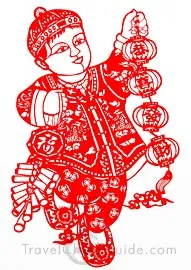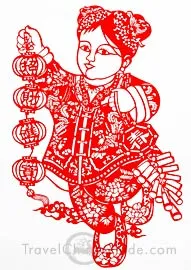Brief Introduction
 |  |
Almost every festival has its own unique origins and customs which reflect the traditional practices and morality of the whole Chinese nation and its people. The grandest and most popular festivals are the Chinese New Year (Spring Festival), the Lantern Festival, the Qingming Festival, the Dragon Boat Festival, the Mid-autumn Festival, etc.
Table of Chinese Traditional Festivals
Festival
|
Date
|
Customs
| |
|---|---|---|---|
| Chinese New Year | 1st - 15th of the first lunar month | pasting scrolls, the character 'Fu', and paper-cuts pictures, setting-off firecrackers and fireworks, paying New Year visits, and eating jiaozi. | |
| Lantern Festival | 15th day of the first lunar month | watching lanterns and fireworks, guessing lantern riddles, performing folk dances, and eating yuanxiao. | |
| Qingming Festival | April 4th or 5th of the solar calendar | tomb sweeping, spring outings, and flying kites. | |
| Dragon Boat Festival | 5th day of the 5th lunar month | dragon boat racing, eating zongzi, wearing a perfume pouch and tying five-colour silk thread, and hanging mugwort leaves and calamus. | |
| Double Seventh Festival | 7th day of seventh lunar month | praying for skillful hands, appreciating the stars, and eating noodles, jiaozi, and wontons. | |
| Mid-autumn Festival | 15th day of the 8th lunar month | appreciating and offering sacrifice to the moonlight and eating moon cakes. | |
| Chongyang Festival | 9th day of the 9th lunar month | eating Chongyang cake, drinking chrysanthemum wine, climbing mountains and appreciating beautiful chrysanthemums. | |
| Winter Solstice | Dec. 21st, 22nd or 23rd in solar calendar | having dumplings in northern areas and having sticky puddings in southern areas | |
| Laba Festival | 8th day of the 12th lunar month | eating laba rice porridge. | |
Timetable of Chinese Traditional Festivals (2011-2020)
| ||||||||
|---|---|---|---|---|---|---|---|---|
| FestivalYear | Chinese New Year | Lantern Festival | Qingming | Dragon Boat | Double Seventh | Mid-autumn | Chongyang | Laba |
| 2011 | Feb. 3 | Feb. 17 | Apr. 5 | Jun. 6 | Aug. 6 | Sep. 12 | Oct. 5 | Jan. 11 |
| 2012 | Jan. 23 | Feb. 6 | Apr. 4 | Jun. 23 | Aug. 23 | Sep. 30 | Oct. 23 | Jan. 1 |
| 2013 | Feb. 10 | Feb. 24 | Apr. 4 | Jun. 12 | Aug. 13 | Sep. 19 | Oct. 13 | Jan. 19 |
| 2014 | Jan. 31 | Feb. 14 | Apr. 5 | Jun. 2 | Aug. 2 | Sep. 8 | Oct. 2 | Jan. 8 |
| 2015 | Feb. 19 | Mar. 5 | Apr. 5 | Jun. 20 | Aug. 20 | Sep. 27 | Oct. 21 | Jan. 27 |
| 2016 | Feb. 8 | Feb. 22 | Apr. 4 | Jun. 9 | Aug. 9 | Sep. 15 | Oct. 9 | Jan. 17 |
| 2017 | Jan. 28 | Feb. 11 | Apr. 4 | May 30 | Aug. 28 | Oct. 4 | Oct. 28 | Jan. 5 |
| 2018 | Feb. 16 | Mar. 2 | Apr. 5 | Jun. 18 | Aug. 17 | Sep. 24 | Oct. 17 | Jan. 24 |
| 2019 | Feb. 5 | Feb. 19 | Apr. 5 | Jun. 7 | Aug. 7 | Sep. 13 | Oct. 7 | Jan. 13 |
| 2020 | Jan. 25 | Feb. 8 | Apr. 4 | Jun. 25 | Aug. 25 | Oct. 1 | Oct. 25 | Jan. 2 |
没有评论:
发表评论